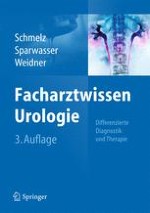Zusammenfassung
Der einseitige isolierte Maldescensus testis stellt mit einer Inzidenz von 3% eine der häufigsten kongenitalen Anomalien dar. Diese hormonell bedingte Fehlentwicklung lässt sich klinisch einteilen in echten Kryptorchismus sowie Leisten-, Gleit- und Pendelhoden sowie die Hodenektopie. Häufig treten Begleitfehlbildungen auf. Mögliche Folgen sind Infertilität und erhöhtes Malignomrisiko. Diagnostisch sind Palpation und Sonografie sowie Laparoskopie (auch zur Therapieeinleitung) wichtig; mit einem HCG-Stimulationstest lässt sich Hodengewebe nachweisen und eine Anorchie ausschließen. Als Therapie (ab dem 7. Lebensmonat) kommen die Hormongabe (GnRH-Nasalspray oder HCG i.m.) und/oder eine Orchidopexie infrage; die Therapie sollte zum 1. Geburtstag abgeschlossen sein. Die Ductus-deferens-Aplasie ist bei beidseitigem Auftreten gehäuft mit einer zystischen Fibrose assoziiert. Eine Phimose (verengtes Präputium) kann konservativ und operativ behandelt werden; die Paraphimose stellt einen Notfall dar. Die angeborene Hydrozele ist Folge eines nicht obliterierten Processus vaginalis in unterschiedlichem Ausmaß. Die besonders schwere Anomalie Prune-belly-Syndrom, bestehend aus Maldescensus testis, Dysplasie der Bauchmuskeln und der ableitenden Harnwege, kann mit ausgeprägten zusätzlichen urogenitalen Fehlbildungen, aber auch Anomalien von Herz, Lunge, Magendarmtrakt u. a. einhergehen. Diese sind oft entscheidend für die schlechte Prognose.











